Mastering the Art of Small Study Room Design: Elevate Your Space on a Budget

Table of Contents
In a world driven by knowledge and constant learning, having a dedicated study space is no longer a luxury; it’s a necessity.
A well-designed study room serves as a sanctuary where the mind can focus, explore, and grow.
It’s a haven where ideas take shape, assignments come to life, and dreams transform into reality.
In this article, we will delve into the art of creating an effective and inspiring study space, even when faced with the challenges of limited space.
The Significance of a Well-Designed Study Space

Picture this: a cozy corner bathed in the soft glow of a desk lamp, a comfortable chair that molds to your posture, and shelves neatly lined with books and resources.
This is not just a study area; it’s your command center for knowledge acquisition and intellectual pursuits.
The significance of a well-designed study space goes beyond aesthetics; it directly influences your ability to learn, focus, and retain information.
A study room tailored to your needs offers numerous benefits:
Concentration: A dedicated study space helps eliminate distractions, allowing your mind to concentrate fully on the task at hand.
Productivity: When everything you need is within arm’s reach, you can maintain a steady workflow without constant interruptions.
Organization: A structured study area encourages organization, ensuring that materials are easily accessible and neatly arranged.
Inspiration: Thoughtful décor and personal touches in your study room can spark creativity and motivate you to dive into your studies.
Mental Association: Over time, your mind will associate this space with learning, making it easier to transition into a focused mindset.
Overcoming Challenges of Limited Space
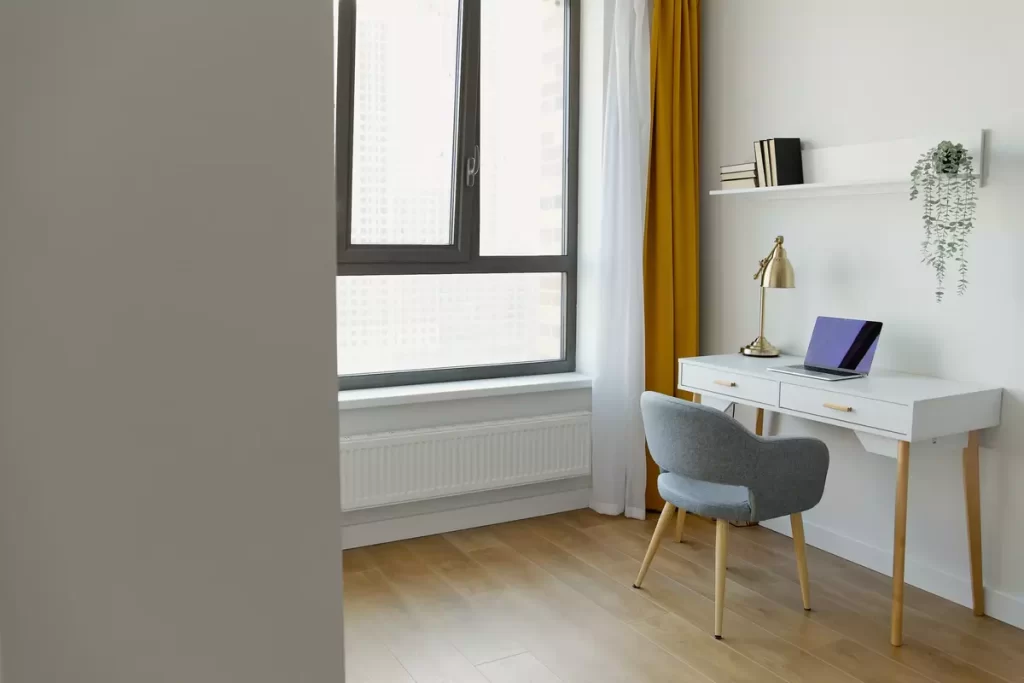
But what if you find yourself in a small living space, seemingly devoid of room for a dedicated study area? Fear not; challenges are merely opportunities in disguise.
In fact, designing a study space within limited dimensions requires a creative approach and efficient use of every square inch.
When space is scarce, every design decision matters:

Multipurpose Solutions: Look for furniture that can serve dual purposes, such as a foldable desk that doubles as a vanity or a wall-mounted shelf that transforms into a study surface.
Vertical Expansion: Utilize vertical space by incorporating tall bookshelves or floating shelves that maximize storage without eating up floor space.
Minimalist Design: Adopt a minimalist approach with streamlined furniture and clutter-free surfaces, enhancing the feeling of spaciousness.
Smart Storage: Seek out furniture with built-in storage options, such as ottomans with hidden compartments or beds with under-bed storage.
Nook and Cranny: Explore corners, alcoves, and unused spaces; these can often be transformed into cozy study nooks.
In the pages that follow, we will explore these concepts in detail, providing you with insights and strategies to design a small study room that’s big on functionality, aesthetics, and inspiration.
Remember, well-designed study space is not just a luxury; it’s a tool that empowers you to excel in your pursuits, regardless of the space constraints you might face.
So let’s embark on this journey of transforming a corner of your world into a place of knowledge and growth.
How to Optimize Functionality and Comfort in Your Small Study Room Design?
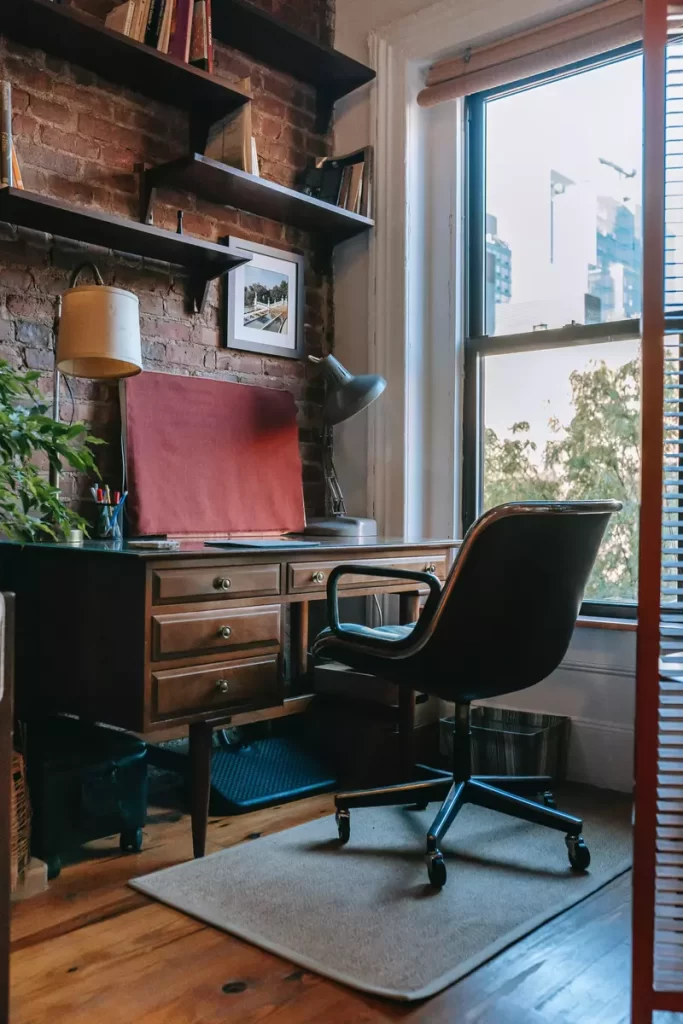
When it comes to small study room design, the key is to make the most out of every inch while ensuring that functionality and comfort remain at the forefront.
In this section, we will explore a range of strategies that help you style your compact study space with purpose and efficiency.
Prioritize Functionality: Choosing Furniture and Décor with Purpose.

In a small study room, every piece of furniture and decor should serve a specific purpose.
Avoid clutter and unnecessary items that can overwhelm the limited space.
Opt for pieces that align with your study needs and enhance the overall aesthetic:
Space-Saving Desk: Choose a compact desk that fits comfortably in your designated study area.
Look for features like built-in storage or pull-out trays for extra functionality.

Ergonomic Seating: Prioritize comfort with an ergonomic chair that supports your posture during long study sessions.
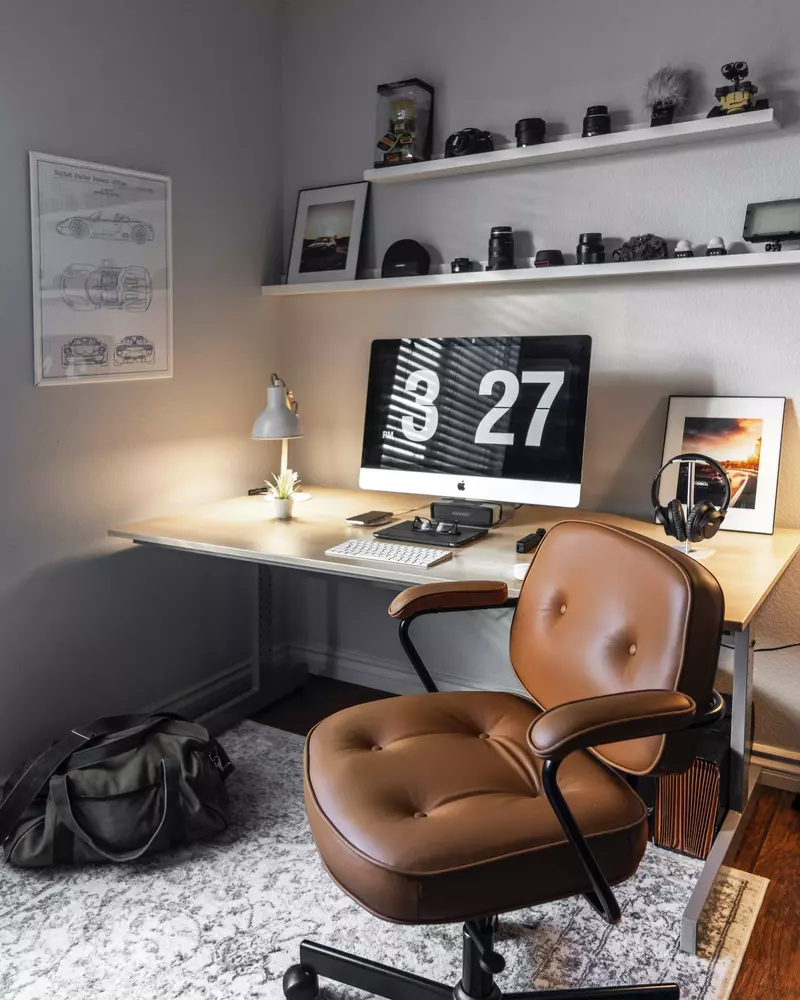
Consider chairs that can be tucked under the desk when not in use.
Opt for Compact Furniture: Folding Desks, Wall Desks, and Multipurpose Pieces

Small study room design demands creative furniture solutions that offer versatility without monopolizing space:
Folding Desks: Choose a folding desk that can be extended when needed and folded away when not in use.
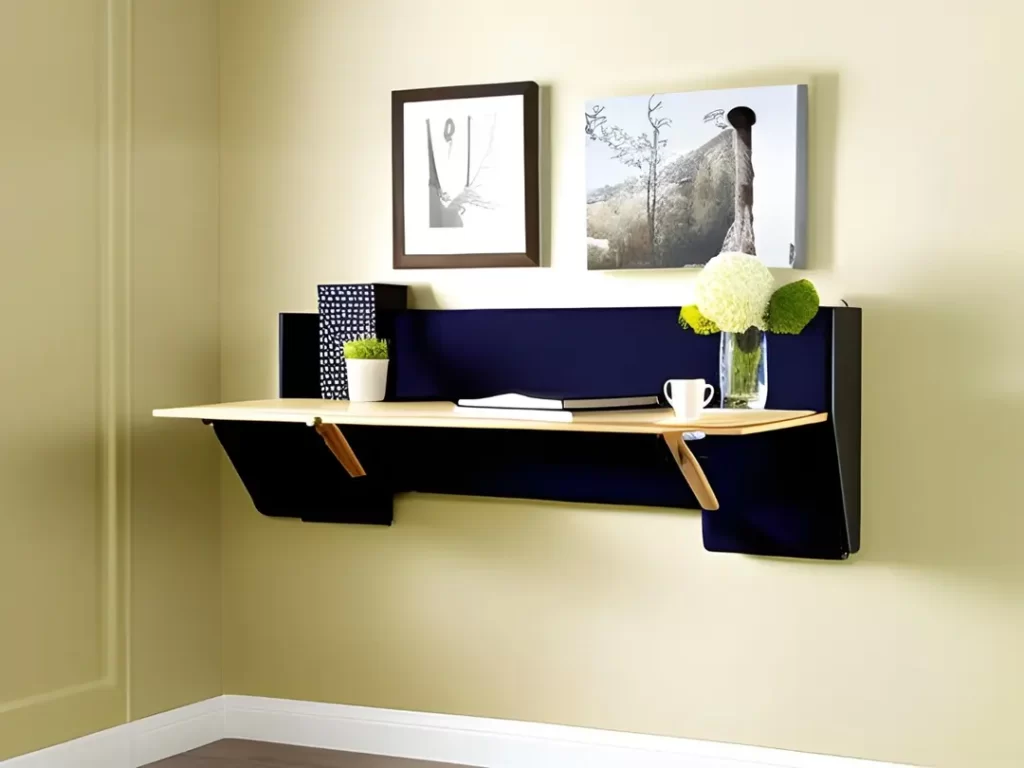
This design keeps the room adaptable to different activities.
Wall Desks: Opt for wall desks that can be flipped down when it’s time to study and flipped up to create more floor space.
Multipurpose Furniture: Invest in furniture with dual functions, such as a storage ottoman that serves as both seating and a place to keep study materials.
Utilizing Vertical Space: Wall-Mounted Shelves and Storage Solutions

When dealing with a small study room, the walls become valuable real estate.
Vertical space utilization is a game-changer, allowing you to store items without sacrificing floor area:
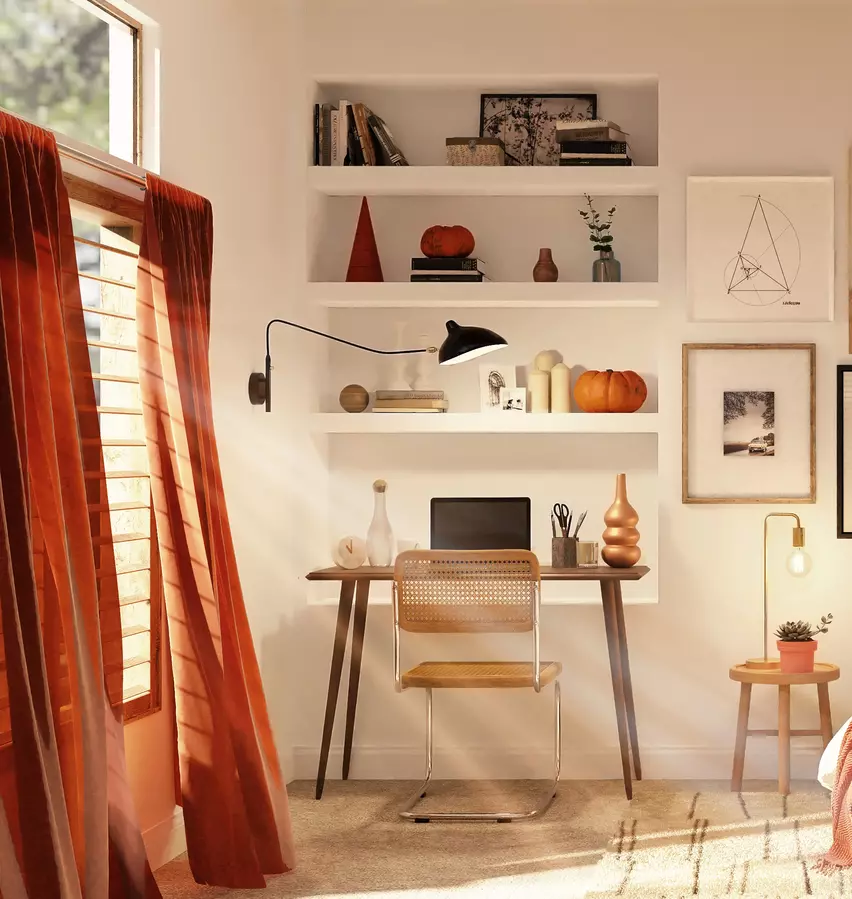
Wall-Mounted Shelves: Install wall-mounted shelves above your desk or around the room to store books, study materials, and decor items.
Floating Desks: Consider a floating desk that attaches to the wall.
This design frees up floor space while providing a functional workspace.
Pegboards: Install pegboards on the wall to hang supplies, organizers, and even plants, keeping essentials within easy reach.
Bright and Efficient Lighting: Desk Lamps, Ambient Lighting, and Task Lighting

Adequate lighting is crucial for a small study room, enhancing focus and reducing eye strain:
Desk Lamps: Select a task lamp for your desk, providing direct light where you need it most while minimizing shadows.
Ambient Lighting: Incorporate ambient lighting, such as wall sconces or pendant lights, to create a well-lit and inviting atmosphere.
Task Lighting: Integrate task lighting for specific areas, like a reading nook or a study corner, to ensure optimal visibility.
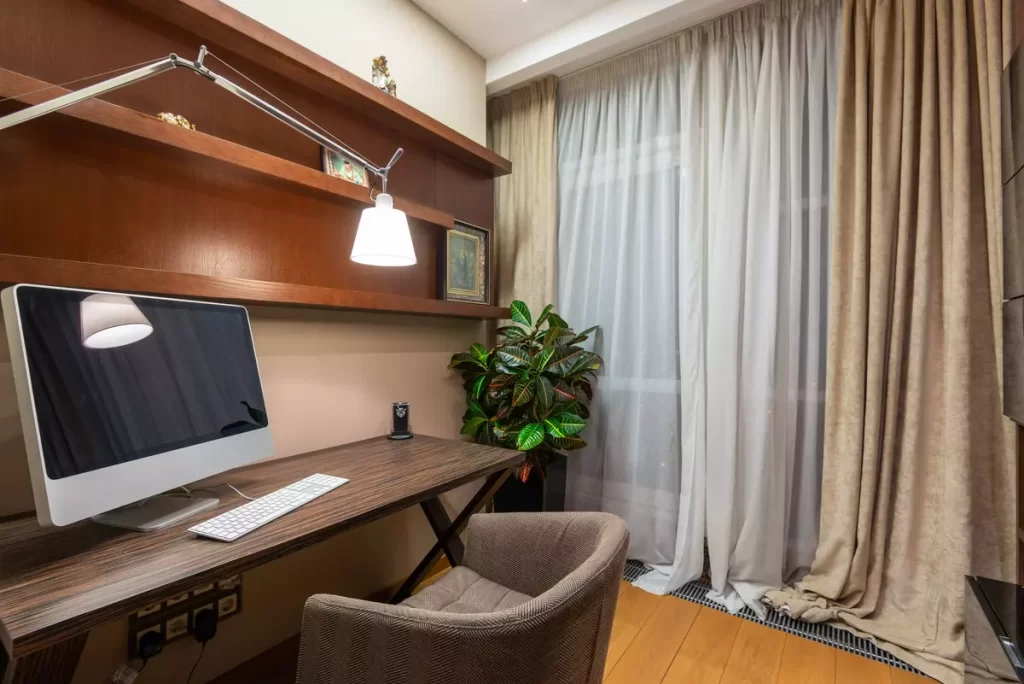
In the world of small study room design, the magic lies in the details.
By prioritizing functionality, utilizing vertical space, opting for compact furniture, and ensuring bright and efficient lighting, you can create a study space that’s both practical and visually appealing.
Remember, in a small space, each choice matters, so make them count to achieve a study room that maximizes potential while embracing the limitations of size.
Essentials of Small Study Room Design: What Makes a Good Study Room
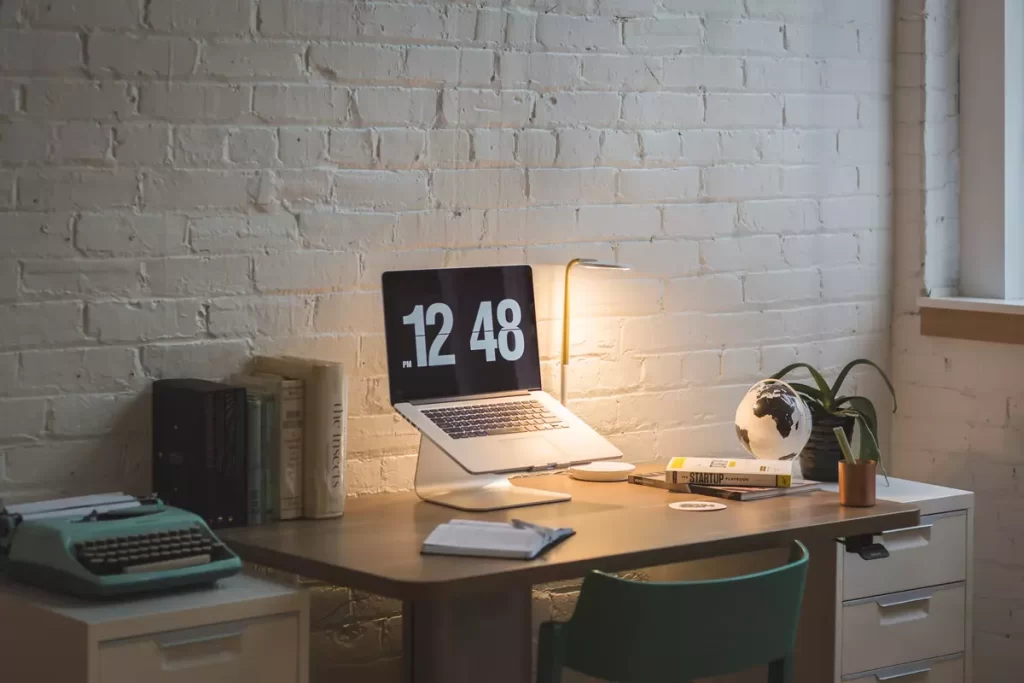
In the realm of small study room design, the objective is to craft a space that encapsulates both practicality and comfort.
What makes a good study room goes beyond its dimensions; it’s about creating an environment that fosters focus, encourages productivity, and supports the learning journey.
Let’s delve into the elements that contribute to an exceptional study space that nurtures your intellect and creativity.
Quiet and Distraction-Free: Locating the Study Space Away from Noise

A cornerstone of a good study room is its ability to provide a serene and distraction-free environment.
Noise and disruptions can hinder concentration and diminish the quality of study sessions:
Dedicated Space: If possible, allocate a corner or section of a room solely for studying to minimize external disturbances.
Proximity to Noise: When planning, consider the proximity to noisy areas like the kitchen or living room. Aim for a quieter location within your space.
Comfortable Seating: Ergonomic Chairs and Cushions for Extended Study Sessions

Comfort plays a pivotal role in maintaining focus and well-being during long study hours.
The right seating can make all the difference:
Ergonomic Chairs: Invest in an ergonomic chair that supports proper posture and reduces the risk of discomfort or strain.
Cushions and Pillows: Incorporate cushions or pillows for additional comfort.
They can provide lumbar support and encourage relaxation.
Organizational Tools: Shelves, Drawers, and Containers for Clutter-Free Storage

An organized study space promotes efficiency and reduces stress.
Clutter-free storage solutions are vital components of a functional study room:

Shelves: Install shelves for books, notebooks, and study materials. Vertical storage minimizes clutter on the desk.
Drawers: Use drawers to keep essentials like stationery and notes within reach, while keeping the desk surface clear.
Containers: Employ containers, bins, and organizers to categorize and store small items like paperclips, chargers, and sticky notes.
Personalization: Adding Motivational Décor and Personal Touches

A study room should be a reflection of your personality and goals.
Personalization not only makes the space inviting but also serves as a source of motivation:
Motivational Quotes: Hang up inspirational quotes or affirmations that resonate with your academic pursuits.
Personal Touches: Integrate decor items that hold sentimental value, like family photos, artwork, or souvenirs from your travels.
Plants and Greenery: Add a touch of nature with indoor plants, which can enhance air quality and create a calming atmosphere.
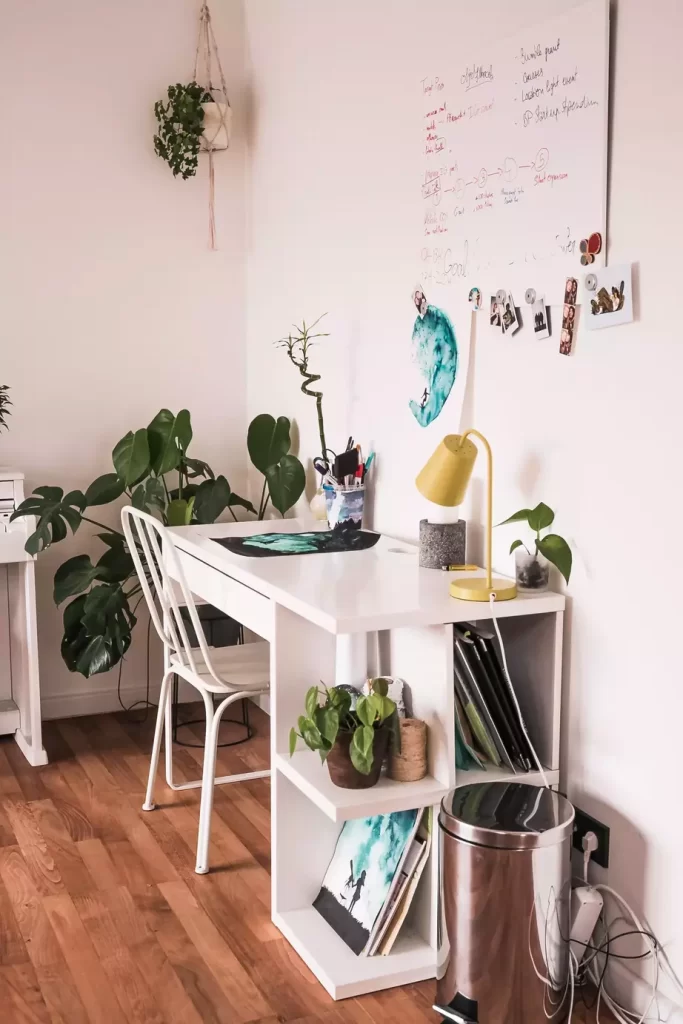
When creating a good study room, remember that the synergy of these elements contributes to a harmonious and enriching study experience.
Quietude, comfort, organization, and personalization work together to shape a space where you can immerse yourself in learning, innovation, and self-discovery.
In the realm of small study room design, it’s not just about maximizing space; it’s about maximizing your potential.
How Do I Make My Small Study Room Aesthetic for Studying: Elevating Functionality with Visual Appeal
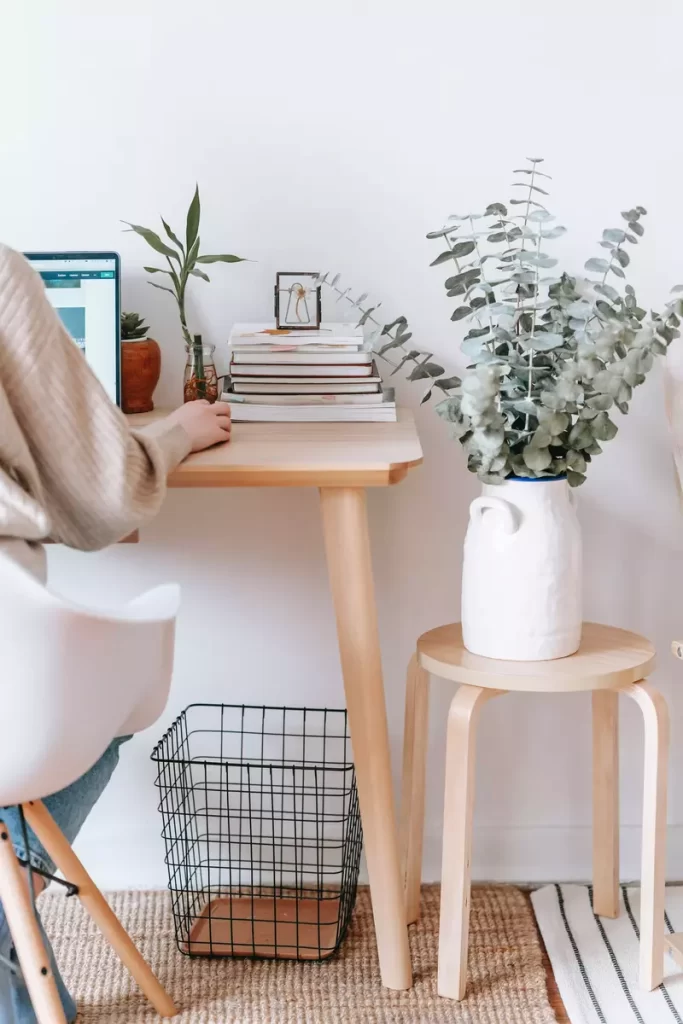
In the world of small study room design, aesthetics and functionality can coexist harmoniously.
Crafting an aesthetic study space goes beyond the visual; it involves creating an environment that nurtures focus and inspires productivity.
Let’s explore the strategies that can transform your compact study room into an aesthetically pleasing haven for effective learning.
Choose a Cohesive Color Scheme: Calming and Focused Colors
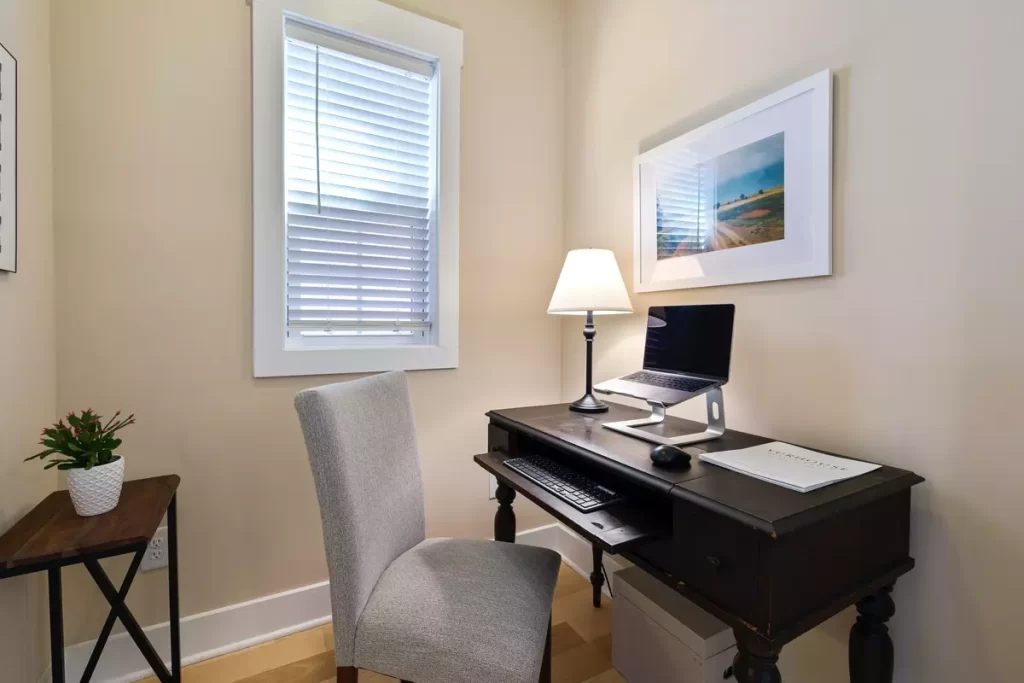
Color has a profound impact on mood and concentration.
When styling your small study room, opt for a cohesive color scheme that fosters a serene yet focused atmosphere:
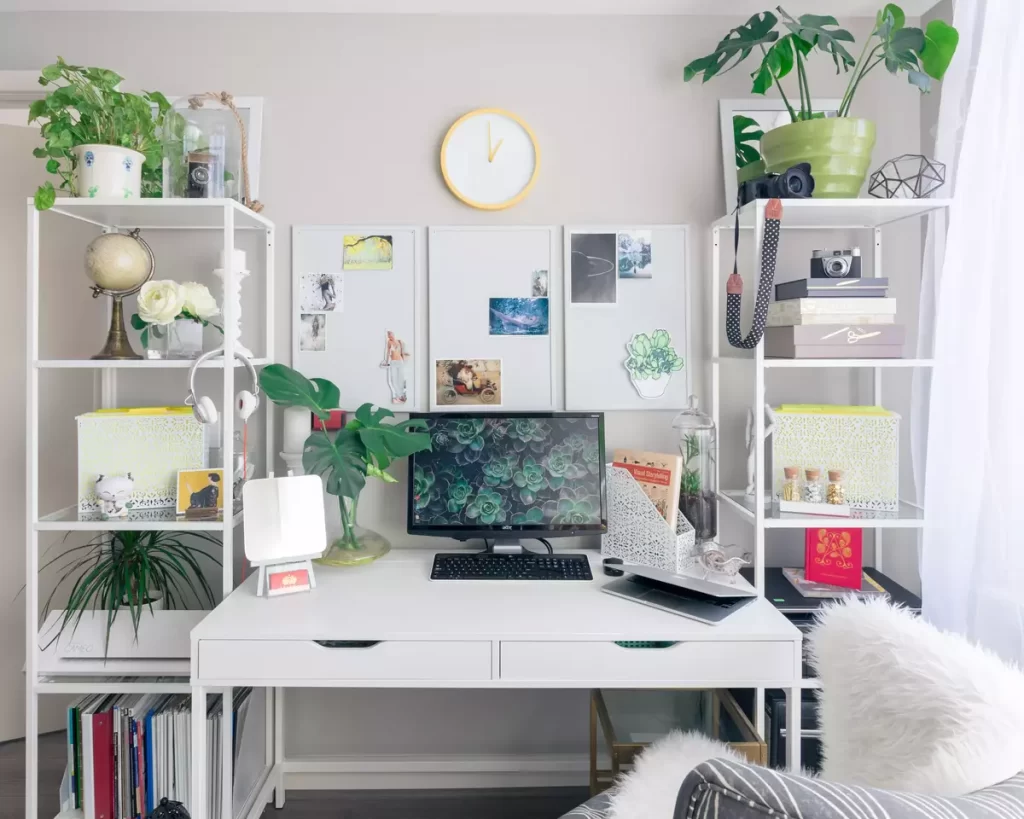
Neutral Tones: Neutral colors like whites, soft grays, and muted pastels create a clean canvas and promote a sense of tranquility.
Accents of Focus: Add accents of colors known for enhancing concentration, such as shades of blue and green.
Wall Décor: Inspirational Quotes, Cork Boards, and Artwork

Wall decor not only adds visual interest but also serves as a source of motivation and organization:
Inspirational Quotes: Hang up motivational quotes that resonate with your academic or personal aspirations.
Cork Boards: Incorporate cork boards for pinning important reminders, study schedules, and inspiring images.
Artwork: Choose artwork that evokes positive emotions and complements your chosen color palette.
Greenery: Indoor Plants for a Touch of Nature
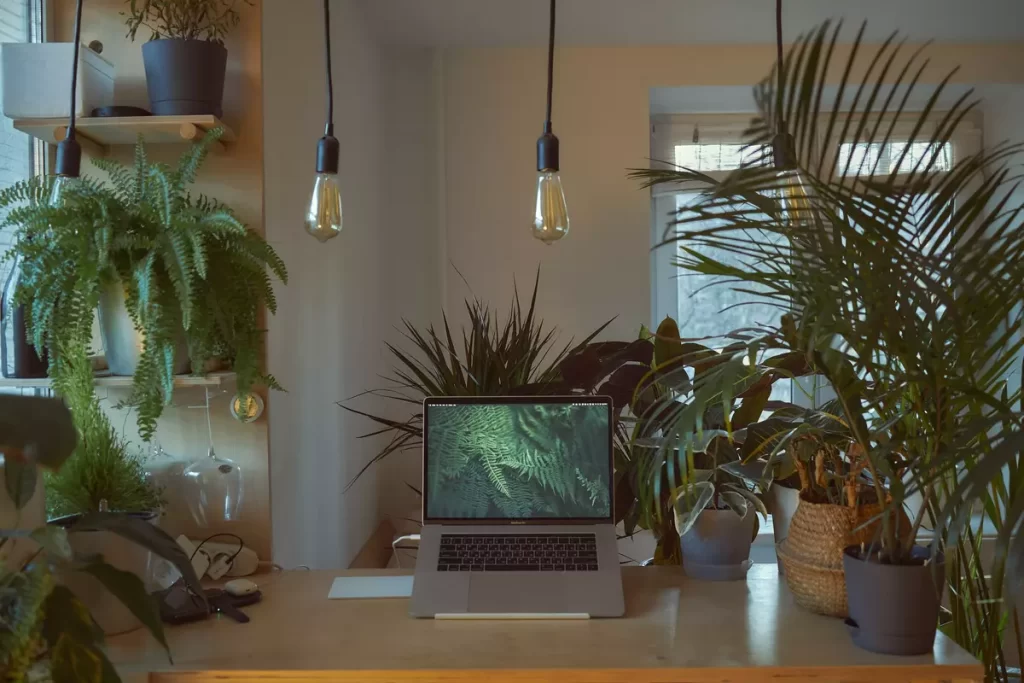
Bringing nature indoors can invigorate your study space and contribute to a calming ambiance:
Indoor Plants: Incorporate indoor plants like succulents, snake plants, or pothos.
These not only add aesthetic appeal but also improve air quality.
Plant Placement: Position plants near windows to take advantage of natural light.
Plants can soften the visual landscape and create a refreshing atmosphere.
Minimalist Approach: Decluttering and Keeping the Space Clean

Aesthetic appeal often stems from simplicity and cleanliness. Embrace a minimalist approach to design:
Declutter: Regularly declutter your study space to ensure that only essentials are present, allowing for better focus and concentration.

Clean Surfaces: Keep your desk and work areas clutter-free, which can help reduce distractions and maintain a visually pleasing environment.
In the pursuit of an aesthetic study room, remember that the goal is not just to make your space visually pleasing, but also to enhance its functionality.
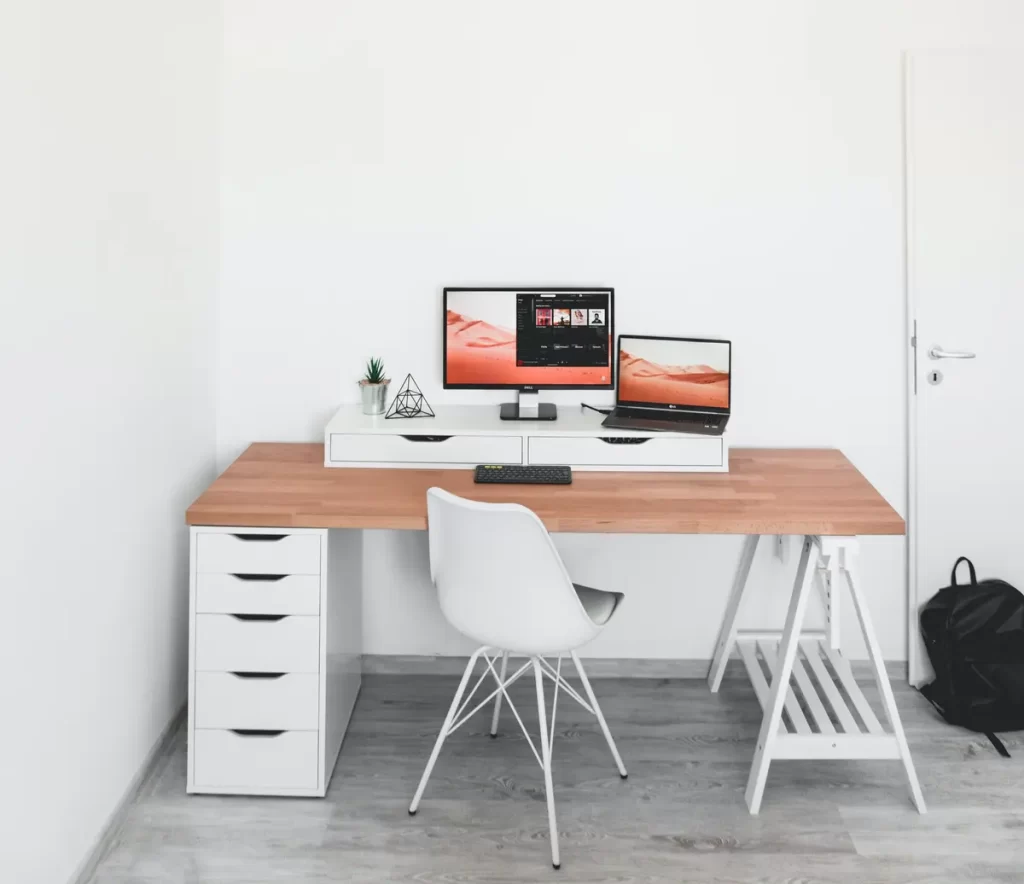
A small study room that marries aesthetics with purpose creates an inviting atmosphere that encourages you to immerse yourself in your studies.
With a cohesive color scheme, thoughtful wall decor, a touch of nature, and a commitment to minimalism, you can curate a space that is not only beautiful but also conducive to deep learning and personal growth.
Ingenious Small Study Room Design on a Budget: Affordable Ways to Decorate

Small study room design doesn’t have to break the bank.
With a dash of creativity and resourcefulness, you can transform your study space into a stylish and functional haven without draining your wallet.
Let’s explore clever ways to decorate your small study room on a budget, proving that design brilliance knows no financial bounds.
DIY Solutions: Repurposing Furniture and Décor Items

Channel your inner designer by breathing new life into existing furniture and decor pieces:
Repurposing Furniture: Give old furniture a makeover with a fresh coat of paint or new hardware.
An old desk or chair can become a statement piece with a bit of DIY magic.
Upcycled Decor: Turn everyday items into decor treasures.
Old mason jars can become stylish pen holders, and wooden crates can transform into chic shelving units.
Thrift Store Finds: Affordable Yet Stylish Furniture

Thrift stores are treasure troves of affordable and unique pieces that can inject character into your study room:
Desks and Chairs: Look for sturdy desks and comfortable chairs that can be polished or painted to match your aesthetic.
Bookcases: Find secondhand bookcases or shelving units to maximize storage space.
Budget-Friendly Organization: Using Containers and Organizers from Discount Stores

Organizational tools can keep your small study room tidy and functional without draining your wallet:
Dollar Stores: Browse dollar stores for containers, bins, and trays that can corral stationery and small items.
DIY Organizers: Craft your own organizers using materials like cardboard, fabric, or even repurposed shoeboxes.
Creative Wall Solutions: Temporary Wallpaper, Washi Tape, or Decals
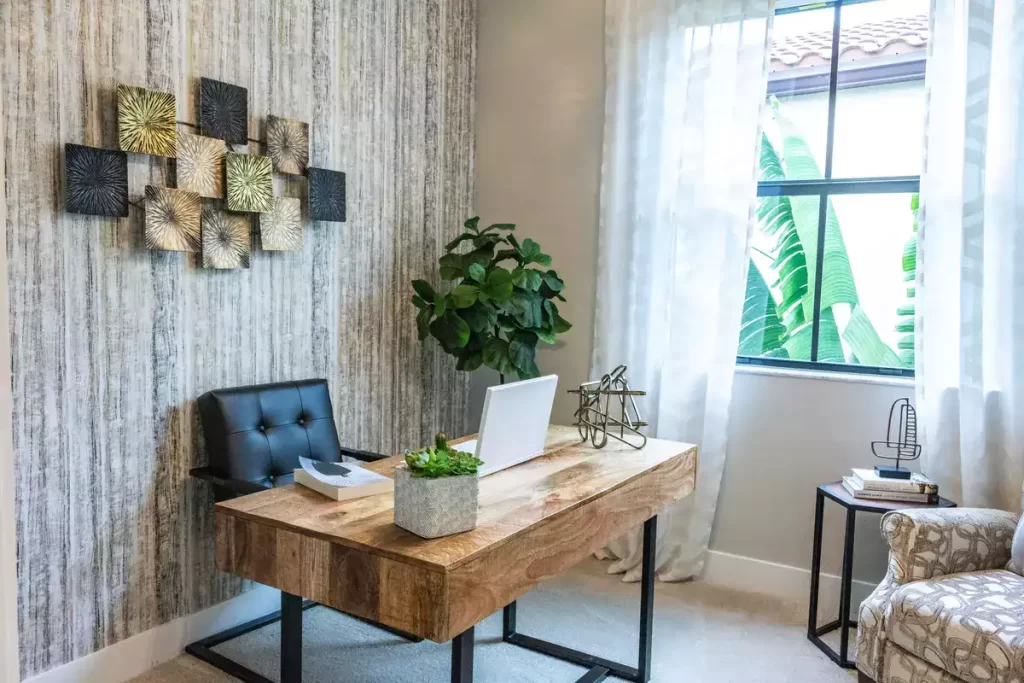
Elevate your study room’s aesthetics with wallet-friendly wall enhancements:
Temporary Wallpaper: Peel-and-stick wallpaper offers a quick and cost-effective way to add patterns and textures to your walls.
Washi Tape: This colorful adhesive tape can be used to create geometric designs, borders, and even faux frames for art.
Decals: Vinyl decals or wall stickers provide artistic flair without the commitment of permanent paint.
When it comes to small study room design on a budget, imagination and resourcefulness are your best allies.
By embracing DIY solutions, hunting for thrift store gems, embracing budget-friendly organization, and exploring creative wall enhancements, you can achieve an inviting and functional study space without stretching your finances.
Remember, it’s not the price tag that defines your study room’s allure, but the thought, effort, and ingenuity you put into making it uniquely yours.
Table Solutions for Optimal Space Utilization for Your Small Study Room Design
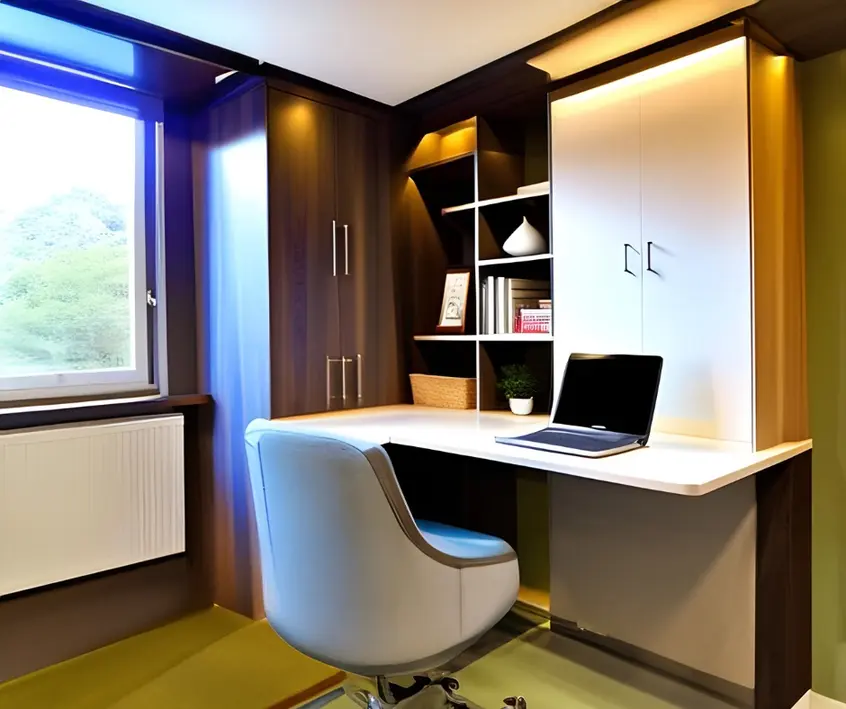
In the realm of small study room design, every square inch counts.
A well-designed study table can make a significant difference in maximizing functionality while maintaining a visually appealing and organized space.
Let’s explore various small study table options that seamlessly blend efficiency and style.
Space-Saving Options: Wall-Mounted Foldable Tables
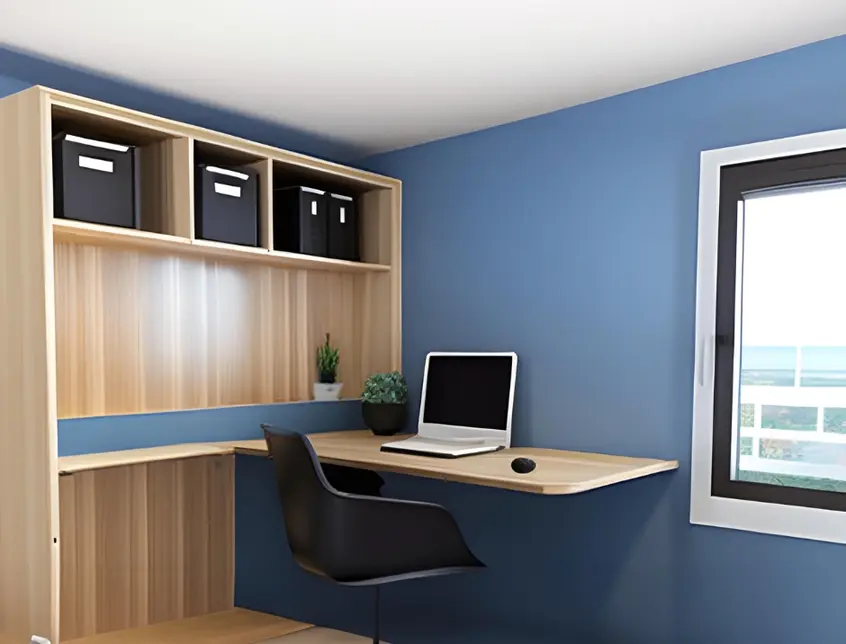
When square footage is limited, the concept of a traditional study table might seem impractical.
Enter the wall-mounted foldable table:
Efficient Foldability: Wall-mounted tables can be folded up when not in use, instantly reclaiming valuable floor space.
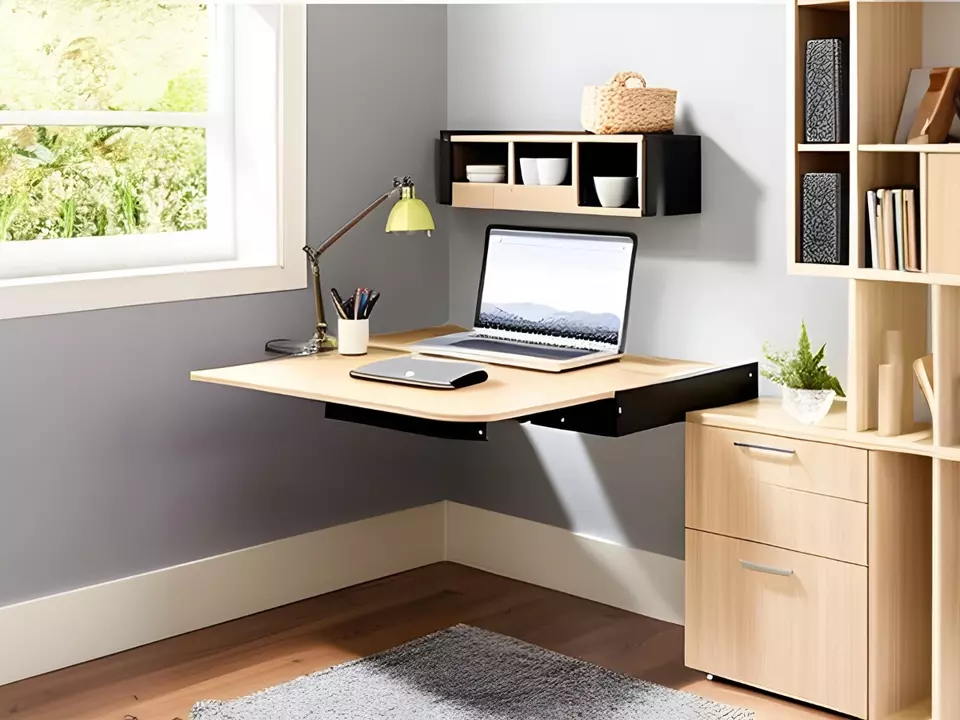
Sleek Aesthetics: These tables appear as unassuming wall decor when folded, contributing to a clutter-free ambiance.
Multifunctional Designs: Study Tables with Built-In Storage

Small study rooms demand creative storage solutions that merge seamlessly with your study table:
Integrated Shelves: Opt for study tables featuring built-in shelves or drawers.
These provide storage for books, stationery, and study materials, reducing clutter on the desk.
Clever Compartments: Some study tables come with hidden compartments or compartments that can be utilized for additional storage.
Corner Desks: Utilizing Corners for Efficient Use of Space

Don’t let the corners of your study room go to waste; employ corner desks to make the most of every inch:
Maximized Space: Corner desks tuck neatly into corners, effectively utilizing an area that might otherwise remain unused.
Enhanced Focus: Placing your study table in a corner can create a focused and secluded atmosphere, free from distractions.

In the world of small study room design, the study table isn’t just a functional piece; it’s a design element that marries practicality with aesthetics.
Whether you opt for space-saving wall-mounted tables, multifunctional designs with built-in storage, or corner desks that harness overlooked areas, your study table should harmonize seamlessly with your overall design vision.
Remember, small doesn’t mean compromising on style or efficiency.
Embrace the ingenious solutions available to you, and transform your small study room into a space that speaks volumes about your creativity and commitment to optimal design.
In the realm of small study room design, size doesn’t define the potential of your space.
Throughout this journey, we’ve explored a multitude of strategies and ideas to create an exceptional study environment that marries aesthetics with practicality.
As you embark on your small study room design journey, take these insights and strategies to heart.
Prioritize functionality, embrace creativity, and infuse your space with your unique personality.
By implementing the tips and ideas shared throughout this article, you’re investing in a study space that is conducive to deep focus, optimal learning, and personal achievement.
So, go forth and apply these insights, infuse your small study room with your unique essence, and create a haven that fuels your journey of knowledge, growth, and success.
